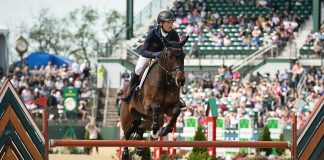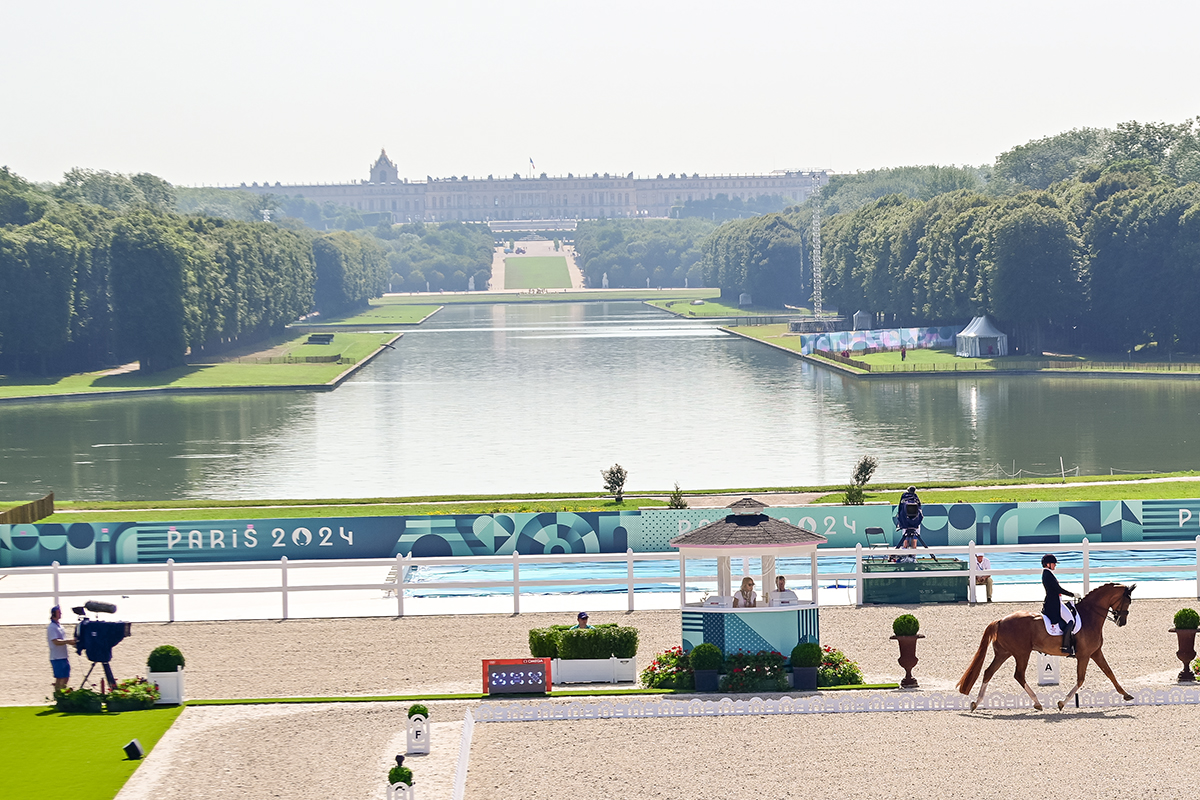
Once the heat of mid-day set in, at least half or more of the crowd sought refuge under the shade trees outside the arena, so the stands looked fairly empty throughout the day. Still, seeing the glittering gold of Apollo’s Fountain outside the Château and small boats paddling on the Grand Canal in the distance was a breathtaking sight during the competition.
Thirty horse and rider combinations from 19 countries took their turns performing the FEI Grand Prix test in the arena, including two from the USA, Marcus Orlob and Jane and Adrienne Lyle and Helix. The riders competed in three groups of 10 with each group being assigned a letter (A, B, C). Other countries represented today were: Australia; Austria; Belgium; Brazil; Canada; Denmark; France; Finland; Great Britain; Germany; Ireland; Lithuania; Moldova; the Netherlands; Poland; Portugal; Singapore; South Korea; Sweden, and Venezuela.
FEI Dressage Rules Summary for the Grand Prix Test
According to the FEI’s Rulebook for the Olympic Games dressage competition, all athletes must participate in the Grand Prix Test. It serves as the qualifying competition for the individual competition (FEI Grand Prix Freestyle, 18 competitors) and the team competition (FEI Grand Prix Special, top 10 teams of three riders each competing, no individual athletes in the Special).
The FEI rules read this way:
Athletes compete in six (6) groups, with three (3) groups competing on the first day and the remaining three (3) groups on the second day. (The composition of the groups are based on the FEI World Ranking List, the position of the horse in the “FEI Dressage World Ranking List – Horses” on the date of definite entries.)
Two from each group, plus the next best six (6) ranked Athletes (overall best results) qualify for the FEI Grand Prix Freestyle. If a qualified Athlete/Horse drops out, the vacant spot is filled by the next best ranked Athlete. In case of a tie, the highest and lowest total scores for each Athlete will be added and divided by two, with the highest score deciding on the tie. If the tie cannot be broken, the second highest and second lowest total scores for each Athlete will be added and divided by two with the highest score deciding on the tie. If the tie is still not broken, the third highest and third lowest total scores for each Athlete will be added and divided by two, with the highest score deciding on the tie. If the tie cannot be broken, it will be decided by a draw. All Teams receive a qualification ranking after the FEI Grand Prix by adding up the three (3) results per team. The top ten (10) ranked Teams (including those tied for the 10th place), qualify for the Team competition, FEI Grand Prix Special. Individual athletes not on teams do not contest the Special.
Scores Summary
The top-scoring rider of the day from all three groups was Nanna Skodborg Merrald riding Zepter for Denmark. They scored 78.028 percent to qualify for the Freestyle from Group A.
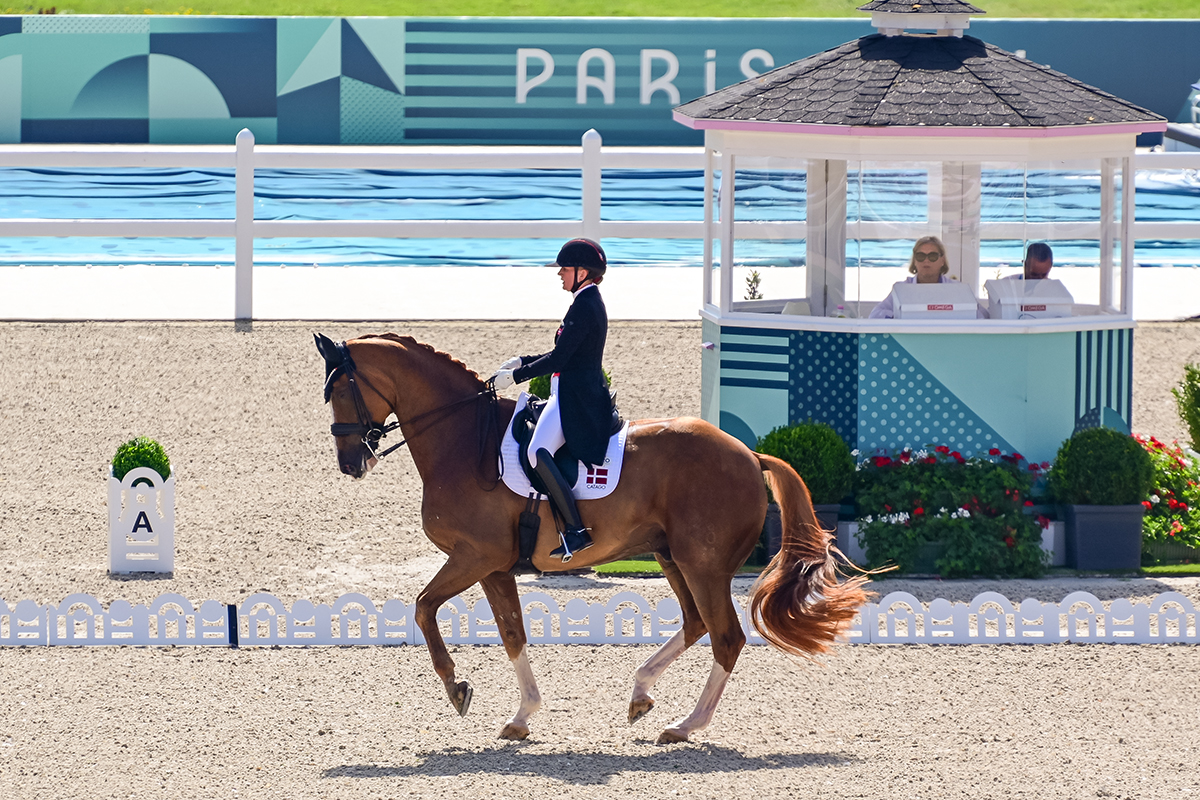
Also qualifying from Group A with the second-best score of the group was Dinja van Liere and Hermes from the Netherlands (77.764). Qualifying from Group B were Denmark’s Daniel Bachmann Andersen and Vayron (76.910) and Germany’s Frederic Wandres and Bluetooth OLD (76.118). And, qualifying from Group C were Great Britain’s Becky Moody and Jagerbomb (74.938) and Sweden’s Patrik Kittel and Touchdown (74.317).
Six more (top two in each group) automatic qualifiers for the Grand Prix Freestyle will be determined tomorrow when Groups D, E and F complete their Grand Prix Tests. Then, after those are determined, the six next-best scores — regardless of which group they were in — will be selected for the Freestyle. That will complete the lineup for the individual dressage medal finals to be held on August 4.
U.S. Rider Performances
Marcus Orlob and Alice Tarjan’s 10-year-old Dutch Warmblood mare Jane were first up for the USA, entering the arena in the seventh spot in Group B. It was the first Olympics for both Orlob and Jane. As they entered the arena to warm up, Jane was tense and bouncing around a bit. But Orlob settled her nicely and they began a beautiful test, showing lovely free, expansive movement. They began canter zig-zags and were headed toward the judge at C. Then that judge, Susanne Baarup from Denmark, rang the bell because she noticed traces of blood on Jane’s right hind fetlock. Orlob pulled Jane up and spoke with the judges.
They were then eliminated due to the FEI’s “no blood” rule. It is suspected that Jane must have stepped on herself when she spooked coming into the arena. Because of Jane’s elimination, the U.S. Team was also eliminated, since it was decided not to substitute in Endel Ots and Bohemian at this late date. (Substitution comes with penalty points assessed to the team, which makes their chance of winning a medal unlikely.)
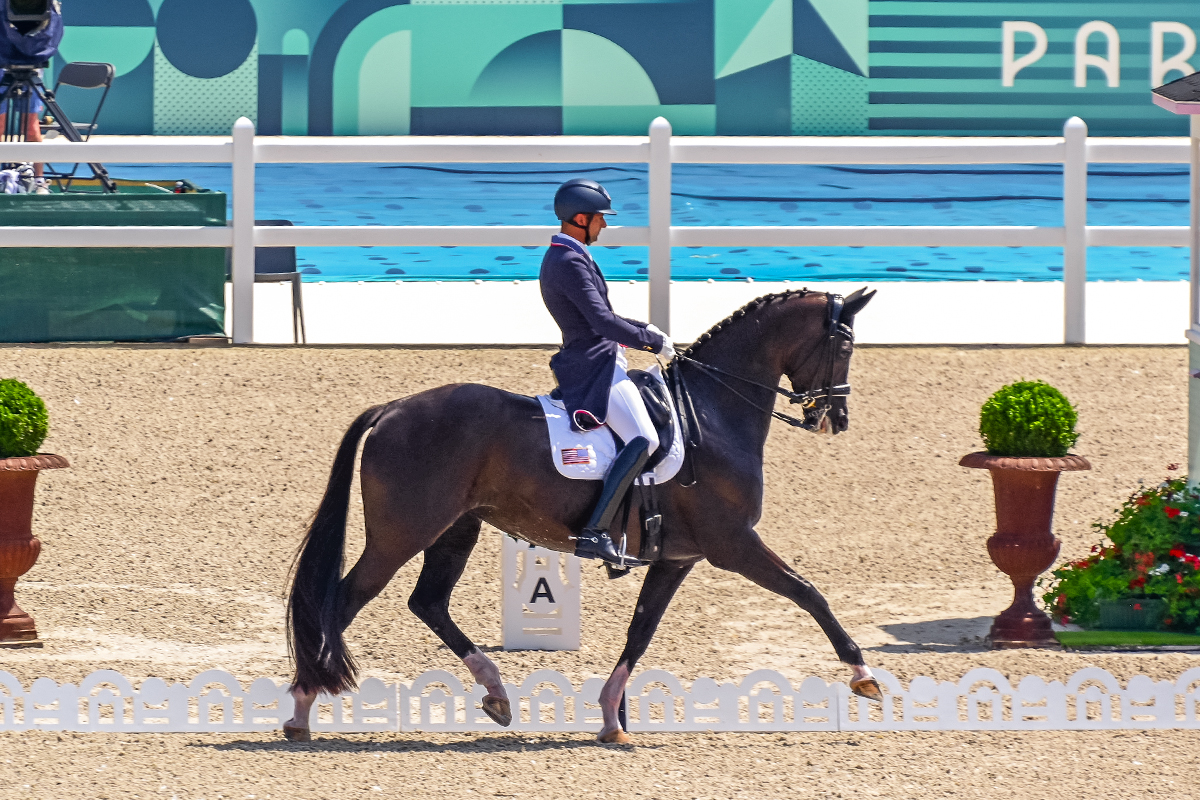
US Chef d’Equipe Christine Traurig spoke about the elimination of Orlob and Jane: “The beginning of the test was beautiful for a horse that is just 10 years old and has done this at this level for [a] very short time, only since February. [Jane] is amazing. That was very unfortunate because up until that point, they were running around a 73%, and it would’ve gone up higher with the canter work and the last centerline.”
The second member of the U.S. Dressage Team to perform today was Adrienne Lyle on the 12-year-old gelding Dutch Warmblood gelding Helix, owned by owned by Zen Elite Equestrian Center. It is the third Olympics for Lyle, who also competed in London in 2012 and Tokyo in 2021. They did their test in the seventh spot in Group C, scoring 72.593 percent. The pair showed lovely freedom in the shoulders and front legs in the half-pass and extended trot and a great ability to “sit” during the piaffe-passage tour and canter pirouettes, as well as nice canter lead changes.
“Adrienne did a fantastic job riding Helix,” Traurig said. “Again, he was on when he entered the arena, and we were thinking, ‘Whoa, definitely plenty of energy there.’ She handled it masterfully. They had a very good score considering this combination is only together for a very short time and did not start the CDIs until earlier this year. It shows you what potential the horse has and what potential Adrienne has as a rider.”
With the U.S. Team eliminated, both Lyle and Peters will compete as individuals going forward in these Paris 2024 Games. It is hoped that their Grand Prix scores will qualify them for the Freestyle. Peters will ride Suppenkasper in the Grand Prix Test tomorrow.
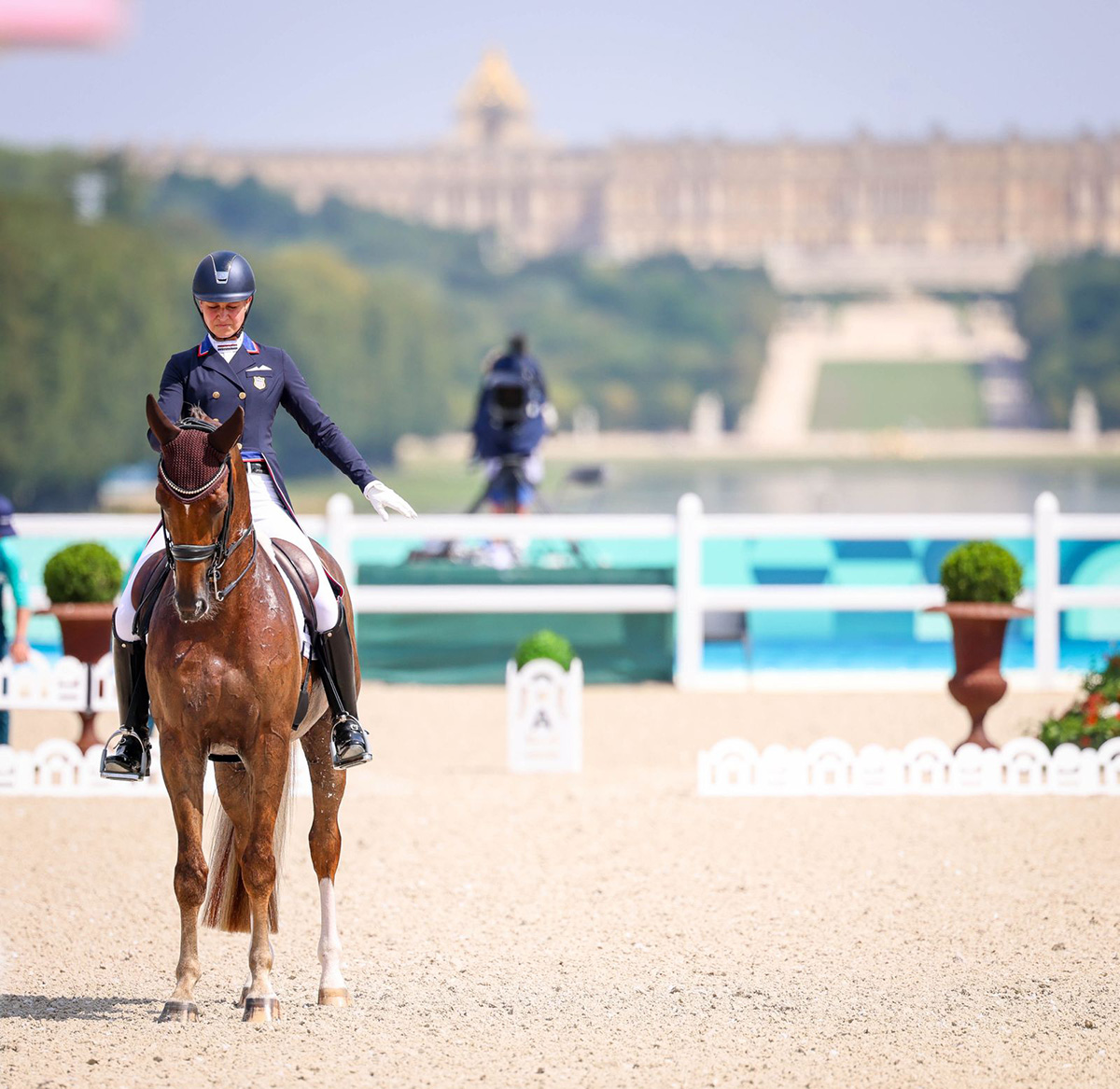
◆ Individual Results
◆ Team Results
Grand Prix Day 2 Preview
Grand Prix day number two is tomorrow with three more groups of 10 horse and rider pairs competing. After the completion of the Grand Prix Tests tomorrow, the 18 individuals for the Freestyle will be named. Competition runs from 10:00 a.m. – 3:30 p.m. Central European Time (4:00 a.m. -11:00 a.m. U.S. Eastern Time).
The U.S. Team’s Steffen Peters and Suppenkasper, a 16-year-old KWPN gelding owned by Four Winds Farm and Akiko Yamazaki, will ride their test at 3:01 p.m. CET (9:01 a.m. U.S. ET). Other notable competitors tomorrow include the current World Champion Glamourdale ridden by Charlotte Fry of Great Britain (ride time 10:00 a.m. CET/4:00 a.m. U.S. ET), current Olympic Champions TSF Dalera BB ridden by Jessica von Bredow-Werndl of Germany (ride time 3:20 p.m.CET/9:20 a.m. U.S. ET), and the most decorated Olympic equestrian ever, Germany’s Isabell Werth riding Wendy (ride time 11:25 a.m. CET/5:25 a.m. U.S. ET).
View tomorrow’s full order of go here.
For broadcast information, go to NBCOlympics.com. All equestrian coverage is streamed live and available for replays on Peacock.
Thanks to CareCredit for our spring and summer equestrian coverage.





